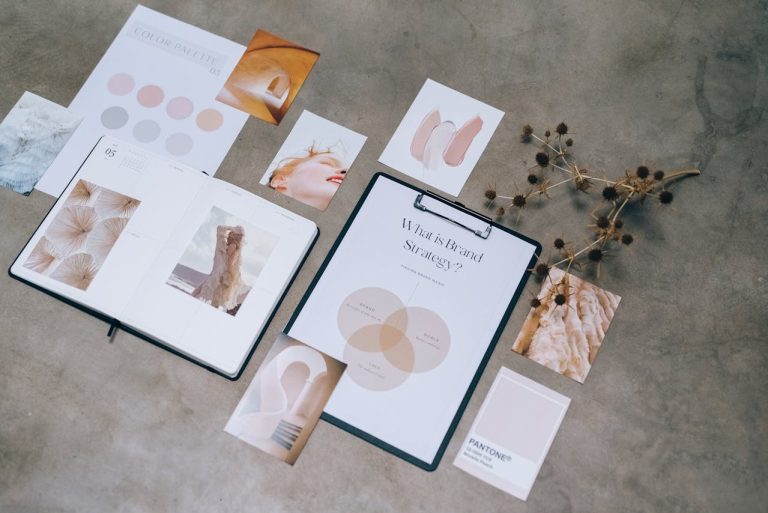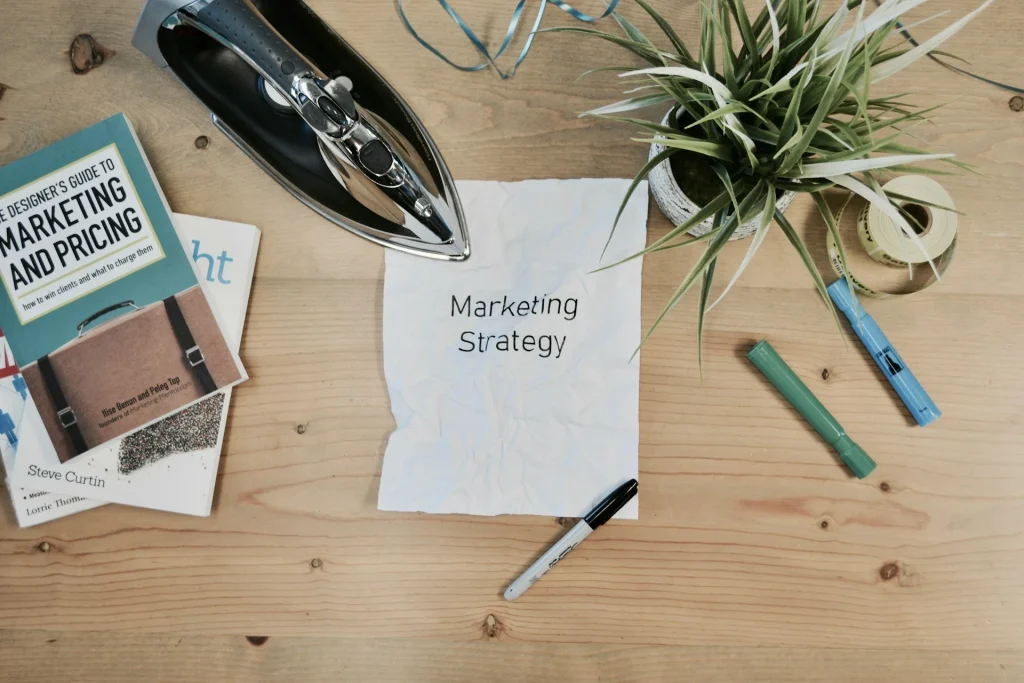

Marketing is rarely a one-click journey. It’s a winding series of steps that guide potential customers from “I’ve never heard of you” to “I can’t stop buying from you.” That’s what a marketing funnel is all about.
In simple terms, a marketing funnel is the path someone takes from discovering your brand to becoming a loyal customer.
It breaks the customer journey into distinct stages, each with its own goals, content types, and tactics.
It’s not a perfect science, but it’s one of the most useful ways to understand, optimize, and scale your marketing efforts.
Quick funnel stats to know
Adding a few data points gives your funnel strategy some weight:
- Businesses that use marketing automation see a 451% increase in qualified leads.
- Retaining a customer is 5–7x cheaper than acquiring a new one.
- 88% of consumers trust online reviews as much as personal recommendations.
- Retargeted website visitors are 70% more likely to convert.
- Top-performing landing pages convert at 11.45%+, while the average hovers around 2.35%.
The marketing funnel is as easy as 1, 2, 3 once you know the steps and get the right tools. So, take a journey with us from the top to the bottom, with tips and examples to help along the way.
How to build your first funnel
You don’t need a complex tech stack or a full marketing team to launch a high-converting marketing funnel. The key is to start simple: one product, one audience, one outcome.
Here’s a beginner-friendly, step-by-step approach to building your first funnel:
- Define your ideal customer: Pinpoint who you want to attract. Think about their goals, frustrations, habits, and buying triggers. The more specific, the better your funnel will convert.
- Identify one core problem you solve: Choose a single pain point that your product or service addresses. This becomes the foundation for your lead magnet, email content, and CTA.
- Create a simple lead magnet: Build a quick-win resource like a checklist, mini-guide, or free tool. Your lead magnet should solve a small part of the larger problem, just enough to build trust and get their email.
- Write a short follow-up email sequence: Plan 3 to 5 emails that educate, demonstrate value, and overcome objections. End the sequence with a compelling offer and deadline.
- Add urgency with Deadline Funnel: Set up a real-time countdown that triggers when someone joins your list. Apply the same deadline across your emails and landing pages to drive action without pressure tactics.
- Build one focused landing page: Keep it clean and direct. Just one headline, one offer, one CTA. Eliminate distractions and match the messaging to your lead magnet or email flow.
- Track KPIs at each stage: Monitor performance across the funnel—traffic, opt-ins, email clicks, sales, and referrals. Use these insights to improve weak points instead of starting over.
The stages of a marketing funnel
Marketing funnels aren’t one-size-fits-all, but most follow the same general structure. Think of them like a map for guiding people from “never heard of you” to “diehard fan.”
Each stage plays a specific role, and skipping steps means missing out on conversions.
Here’s a more complete look at each phase and how to actually make it work.
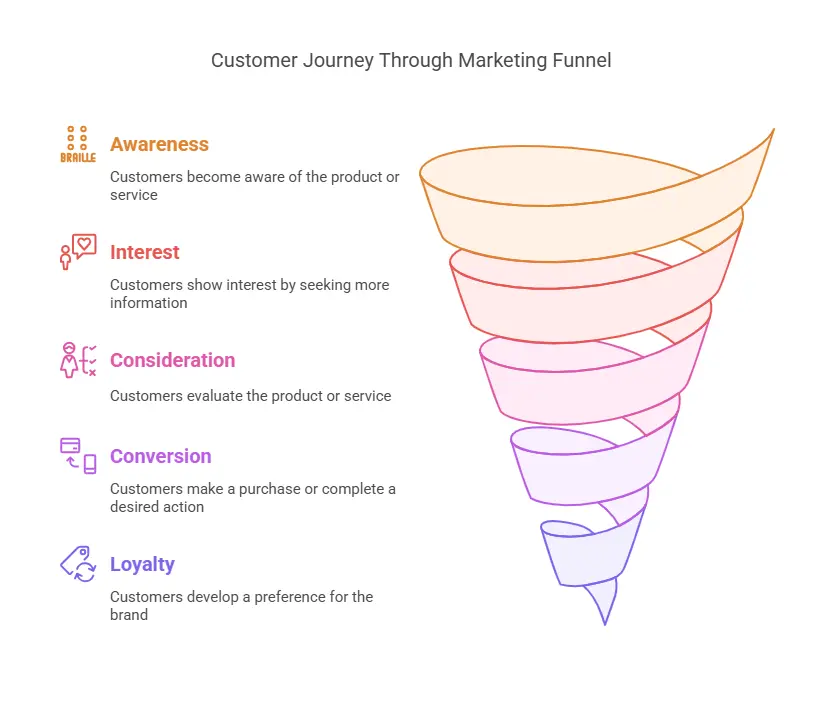
1. Awareness stage: Make them notice you

This is your first impression. The awareness stage is where cold audiences first encounter your brand. They aren’t actively looking to buy, and they may not even recognize their problem yet. Your goal is simple: show up early and get remembered.
Example: A skincare startup launches TikTok videos explaining the science behind niacinamide and retinol. Instead of selling, they deliver bite-sized, engaging education. Viewers follow, engage, and enter the funnel passively, without clicking “Buy Now.”
Your goal: Get in front of the right people with high-relevance messaging.
What works here
- SEO blog content targeting informational queries (e.g., “what does niacinamide do?”)
- Social posts that spark curiosity or teach something visual
- YouTube explainer videos optimized for search
- TikTok, Reels, or Shorts built around quick value (not promotion)
- Influencer collabs that anchor your brand to a trusted face
- Value-first ads (e.g., quiz or guide download, not a sales page)
Why this matters
Search engines and visual content play a huge role at the top of the funnel.
68% of online experiences start with a search engine.
→ Ahrefs SEO statistics report for 2024 confirmed organic search remains the dominant channel for digital discovery.
90% of consumers say video helps them make buying decisions.
→ Wyzowl’s State of Video Marketing 2024 shows that short-form explainer videos increase recall and brand consideration.
Social media drives 3x more discovery for Gen Z than search engines.
→ According to Google’s own internal data reported by TechCrunch, nearly 40% of younger users use TikTok or Instagram to find info instead of Google.
KPIs to track in the Awareness stage
You will need to track Key Performance Indicators (KPIs) to see if your content is being seen, remembered, and generating curiosity in the awareness stage.
The metrics below show how effectively your awareness campaigns attract attention and initiate the customer journey.
| KPI/Metric category | What to measure |
| Traffic | Sessions from organic search, social media, and paid campaigns |
| Reach | Impressions and unique views on social or video content |
| Engagement | Average video view duration, % of new vs returning website visitors |
| Search performance | Organic keyword rankings, click-through rates (CTR) from SERPs |
Pro tip: This is not the time to sell. Create content that’s informative, surprising, or entertaining. Your aim is to be remembered, not to close a deal.
2. Interest stage: Build curiosity and trust

Once someone is aware of you, the next step is earning their interest. This is where you go deeper: help them understand what you do, why you matter, and how you might fit into their world.
Example: ConvertKit (Now Kit) offers a free email list-building course for creators. It’s packed with value, delivered over email, and builds goodwill before pitching anything. By the time someone finishes the course, they’re already primed to consider the product.
Your goal: Capture attention and build trust.
Effective strategies
- Lead magnets like checklists, cheat sheets, or short guides. These are still one of the most effective tools for growing email lists. According to GetResponse, the best-performing lead magnet pages convert between 20% and 40% of visitors.
- Webinars and trainings that teach something specific. ON24 reports that the average webinar conversion rate is around 44%, especially when paired with email follow-up.
- Email newsletters that give value up front, not just product updates. Email remains one of the highest-performing marketing channels, with an average ROI of $36 for every $1 spent (Litmus).
- Trust signals like social proof, press mentions, or showing the number of customers or subscribers you already have.
- Free tools or mini-courses that solve a small problem and keep people engaged with your brand.
Why this matters
The interest stage is your chance to turn passive attention into active interest. Well-designed lead magnets, educational content, and nurturing emails don’t just build your list; they create a stronger connection. And those connections are far more likely to convert later.
What to avoid: Don’t make it all about you. Focus on solving problems, sharing value, and being helpful. You’re building a relationship, not pushing a product. People want to know: what’s in it for me?
KPIs to track in the Interest stage
Once you’ve captured someone’s attention, these Interest stage KPIs show whether your content is building real engagement or just surface-level clicks.
| KPI/Metric category | What to measure |
| Lead magnet conversion rate | % of visitors who opt in after viewing your lead magnet |
| Webinar sign-up rate | # of registrations compared to landing page traffic |
| Email open rate | % of subscribers opening your nurture emails |
| Email click-through rate | % of readers clicking links inside your emails |
| Time on page/scroll depth | Avg. time spent or % of page viewed on educational content |
| New subscriber growth | Total # of new email contacts added over a defined time period |
3. Consideration stage: Show them you’re the right choice
At this point, your audience is problem-aware and actively comparing solutions. They’re weighing their options, and you want to make it easy for them to choose you.
Example: Notion, popular task management software, uses detailed feature comparison pages to help people evaluate it vs tools like Evernote or Trello. They also showcase real user testimonials and integrations that address specific audience pain points.
Your goal: Position your brand as the most credible, valuable option.
Tactics to use
- Detailed comparison content. Whether product vs. alternative or tiers vs. tiers, buyers often use these to decide. Funnels guide users by aligning content with decision-stage questions.
- Case studies & customer stories. Prospects are 6× more likely to convert after reading case studies, according to Userpilot.
- Interactive demos, calculators, quizzes. Tools that answer personalized questions can improve engagement. Leads spend more time comparing options and feel confident making decisions.
- Personalized email sequences. Automated emails triggered by behavior (e.g., visited pricing, downloaded guide) perform significantly better. Personalized emails see 26% higher open rates, and marketers have observed a 760% rise in email revenue generated from segmented campaigns.
Tip: Make sure every consideration-stage asset is mobile-friendly. People are researching on the go.
Why this matters
The consideration stage is where trust turns into intent, and the right content can make a major impact. Case studies, for example, can boost B2B conversions by up to 70%, showing real-world proof of your value.
Retargeting also plays a big role here, with retargeted visitors being 43% more likely to convert. And when you trigger personalized emails (like including pricing page reminders, feature highlights, or tailored case studies), you nurture trust and guide those potential customers toward action.
KPIs to track in the Consideration stage
At the Consideration stage of your marketing funnel, you’re tracking whether potential buyers are engaging with decision-focused content and moving closer to action.
| KPI/Metric category | What to measure |
| Demo or trial requests | # of users who request a demo, sign up for a trial, or interact with a product tour |
| Feature page engagement | Time on page, click-through rate to deeper product content, scroll depth |
| Case study views or downloads | Total visits, downloads, or time spent on success story pages |
| Webinar attendance rate | % of registrants who attend the live session or view the replay |
| Retargeting ad engagement | Click-through or conversion rate from ads shown to warm leads |
| Quiz or calculator completions | % of visitors who complete interactive tools designed to aid decision-making |
4. Conversion stage: Make buying the easy choice
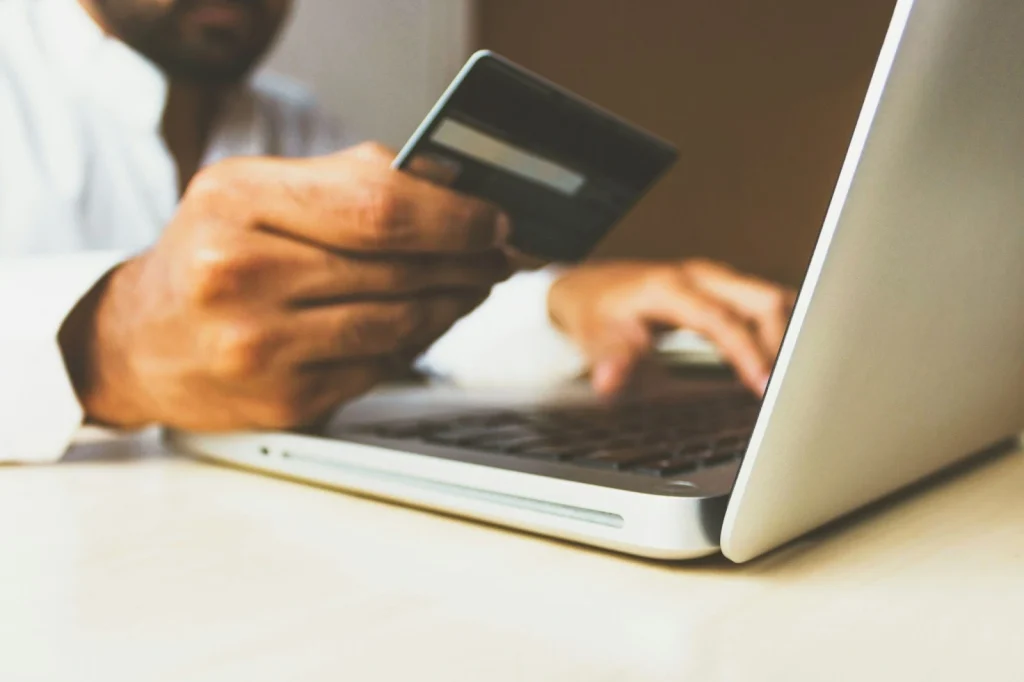
This is the “let’s go” moment. If they’ve made it this far, the only thing left is to give them a reason to act now. Think frictionless UX, compelling CTAs, and time-sensitive offers.
Example: Many SaaS brands offer a 14-day free trial with no credit card required. That eliminates friction and gets people into the product fast. Calendly, for example, pushes users into onboarding immediately to shorten time-to-value.
Your goal: Remove barriers and drive the sale.
Conversion boosters
- Free trials or freemium access. Research by PYMTS indicates that more than 54% of consumers continued their subscriptions once their free trials expired.
- Time-sensitive offers. Countdown timers and limited-time discounts can increase conversions by up to 27% (8thdial).
- Risk reversals (money-back guarantees, no-commitment policies). Reduce perceived risk and build confidence, especially in price-sensitive markets.
- Live demos or 1:1 consultations. Personalized walk-throughs often close more deals. B2B buyers especially value conversations with reps in the final stage.
- Automated urgency using tools like Deadline Funnel. Evergreen or real-time countdowns create consistent, personalized deadlines across your funnel.
Big mistake to avoid: A vague or buried CTA. Be bold. Tell people exactly what to do next and why now is the right time.
Why this matters
At the conversion stage, clarity and incentives can make all the difference. Landing pages with a single, focused CTA convert 2.5x better than those with multiple calls to action.
Shoppers also respond to value: 60% say they’re more likely to make a purchase if there’s a discount code available. And in SaaS, offering a free trial can increase conversion rates by as much as 66%, helping users experience the product before committing.
Purchase decisions are often emotional. If you delay the decision or make it complex, conversion rates drop. Clear offers, urgency triggers, and smooth UX can make the difference between “maybe later” and “I’m in.”
KPIs to track in the Conversion stage
This is where the results show. Use these KPIs to measure how many people say “yes.”
| KPI/Metric category | What to measure |
| Sales or sign-ups | Total conversions from trial, checkout, or sign-up pages |
| Conversion rate | % of users completing a purchase or registration after hitting a landing page |
| Abandonment rate | % of users who start but don’t complete the sign-up or checkout flow |
| Time-to-convert | Average number of days between lead capture and conversion |
| Offer redemption rate | % of users who redeem time-sensitive discounts or bonuses |
| Deadline Funnel-assisted conversions | Conversions tied to personalized deadline campaigns across email and landing pages |
5. Loyalty stage: Keep them coming back

Customer retention is where your profit margin lives. Loyalty isn’t built through luck; it’s earned through great onboarding, thoughtful communication, and consistent post-purchase value.
Example: Chewy, the pet supply brand, is famous for sending personalized handwritten cards and surprise gifts to customers. This low-cost gesture leads to massive word-of-mouth and repeat purchases.
Your goal: Turn customers into repeat buyers.
Smart loyalty strategies
- Onboarding emails with how-to content or best practices
- Personal post-purchase check-ins or surprise offers
- Exclusive discounts for returning customers
- Loyalty or referral programs
- Engaging product education content (e.g., tutorials or pro tips)
Why this matters
Loyalty isn’t just about warm feelings – it’s a major growth driver! Repeat customers spend 67% more than new ones, and the likelihood of selling to an existing customer is as high as 70%, compared to just 5–20% for new leads.
On top of that, brands that prioritize customer experience generate 5.7x more revenue, proving that post-purchase engagement is just as important as acquisition.
When you learn that 65% of a company’s business comes from repeat customers (SmallBizGenius), you know just how valuable nurturing those relationships is.
KPIs to track in the Loyalty stage
These Loyalty stage KPIs reveal whether customers come back, stay longer, and deliver more value over time.
| KPI/Metric category | What to measure |
| Repeat purchase rate | % of customers who buy more than once within a defined period |
| Customer lifetime value (CLV) | Average revenue generated per customer over their entire lifecycle |
| Post-purchase email engagement | Open and click-through rates for onboarding and loyalty sequences |
| Redemption rate on loyalty rewards | % of customers using points, discounts, or VIP benefits |
| Churn rate | % of customers who stop buying after a specific timeframe |
6. Advocacy stage: Let your customers do the talking

This is the top-tier goal: create customers who sell your product for you. When people have a genuinely great experience, they’ll talk about it. Your job is to make that easy (and rewarding).
Example: Canva encourages users to share their designs on social media with branded hashtags. This UGC turns casual users into brand ambassadors while giving the product more reach without paying for ads.
Your goal: Turn happy customers into enthusiastic promoters.
Advocacy tools
- Referral bonuses for both the referrer and their friend
- Easy-to-share templates or pre-written copy for social proof
- Affiliate programs for influencers or high-referral users
- Public reviews and testimonial requests post-purchase
- Featuring real customers in your content or newsletters
Why this matters
Advocacy turns loyal customers into your most powerful marketing asset. A full 92% of consumers trust referrals from people they know, making word-of-mouth one of the most credible and effective forms of promotion.
It also delivers results: word-of-mouth marketing drives $6 trillion in annual spending and accounts for 13% of total sales. Even better, customers acquired through referrals have a 37% higher retention rate, making them more likely to stick around for the long haul.
What works best: Authenticity. Real voices, not forced marketing copy, build the kind of trust that paid ads can’t touch.
KPIs to track in the Advocacy stage
The Advocacy stage metrics show the effectiveness of your advocacy programs and the strength of your brand’s word-of-mouth.
| KPI/Metric category | What to measure |
| Net Promoter Score (NPS) | Promoter percentage minus detractor percentage from endorsed surveys |
| Referral rate | % of new customers acquired via existing customer referrals |
| Number of reviews / UGC posts | Volume of customer-generated content and public testimonials |
| Social share volume | # of shares, mentions, or tags tied to your brand |
| Advocate-generated pipeline | Revenue or leads directly tied to referrals or ambassador efforts |
Why marketing funnels matter
If you’re winging your marketing without a funnel, you’re basically gambling with your budget. Funnels bring structure and predictability to what would otherwise be chaotic.
Here’s why that matters:
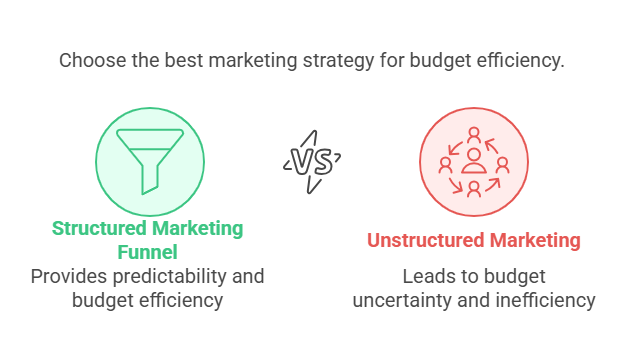
You meet people where they are
Instead of blasting one-size-fits-all messaging, a funnel helps you tailor content based on where someone is in the decision process. That means less guesswork and more conversions.
Marketers using segmented campaigns see a 760% increase in revenue.
You guide users instead of losing them
Without a funnel, leads can fall through the cracks. But with a mapped-out journey, you’re creating a logical next step at every stage.
Companies that excel at lead nurturing generate 50% more sales-ready leads at 33% lower cost.
You get clearer data
Funnels aren’t just good for planning; they’re good for analysis, too. You can track drop-off points, see which content actually moves people forward, and spot bottlenecks that are killing your conversions.
You focus your efforts where they matter
If most leads are dropping off in the middle of the funnel, why keep dumping ad spend into awareness? A funnel helps you zoom in on weak links and fix them, saving time and money.
You improve ROI across the board
Better segmentation, stronger targeting, and clearer messaging at each stage = more efficient marketing and higher funnel ROI. Whether you’re a solo founder or a full-scale team, that kind of clarity compounds over time.
Businesses using marketing automation to nurture prospects see a 451% increase in qualified leads.
If you want to calculate your possible marketing funnel return-on-investment, check out our free funnel ROI calculator.
Marketing funnels that work
The most successful online businesses are using structured marketing funnels to turn attention into conversions, 24/7.
Below are real-world examples of creators and entrepreneurs using Deadline Funnel to build high-performing marketing funnels that drive serious growth.
Abbey Ashley – The Virtual Savvy
📌 Funnel type: Evergreen lead magnet → Email course → Countdown to close
🎯 Goal: Automate course sales without launching every month
📈 Result: Scaled from $10K to $60K/month in evergreen course revenue
🔁 Key mechanism: Deadline Funnel personalized the course offer for every subscriber, creating real urgency without manual work.
Chandler Bolt – Self-Publishing School
📌 Funnel type: Lead magnet → Evergreen webinar → Limited-time offer
🎯 Goal: Replace live launches with a scalable, automated funnel
📈 Result: Built a $5M+ business using evergreen webinars
🔁 Key mechanism: Deadline Funnel synced the webinar replay access window and offer expiration to create conversion pressure.
Gabe Schillinger – Legion Beats
📌 Funnel type: Multi-step lead magnet → Product launch → Fast-action deadline
🎯 Goal: Convert a cold audience into buyers in days
📈 Result: Multiple $1M+ funnels using urgency and segmentation
🔁 Key mechanism: Launch funnels with dynamic countdown timers across landing pages and email flows.
These aren’t just testimonials. They’re playbooks. Each of these marketing funnels followed the proven pattern: attract → nurture → convert → repeat, with Deadline Funnel closing the gap between interest and action.
Common funnel mistakes (and how to avoid them)
Even the best brands misfire when it comes to building and managing their funnel. Here are a few common traps to avoid and how to fix them.
Mistake 1: Selling too early
Pushing a hard CTA during the awareness stage is a fast way to lose trust. People need time to warm up.
Fix: Keep early-stage content focused on education or entertainment. Sell later after trust is built.
Mistake 2: Treating every lead the same
A cold lead who just downloaded your ebook isn’t ready for the same message as someone who’s viewed your pricing page twice. Leads nurtured with targeted content produce a 20% increase in sales opportunities.
Fix: Use segmentation and behavior-based triggers in your emails and retargeting ads.
Mistake 3: Relying on one channel
If your funnel depends entirely on Instagram or Google Ads, one algorithm shift can tank your visibility.
Fix: Diversify your traffic sources. Build owned channels like email and SEO for resilience.
Mistake 4: Ignoring the post-purchase experience
Many brands go silent after a sale, which is a big mistake! That’s where loyalty, referrals, and retention are made (or lost).
Fix: Create post-purchase touchpoints that feel thoughtful, not automated.
Mistake 5: Not reviewing funnel performance
If you’re not measuring what’s working and what’s not, you can’t improve it. Companies that measure ROI are 1.6x more likely to receive higher budgets for future marketing campaigns.
Fix: Regularly review each stage’s performance using tools like Google Analytics and heatmaps.
Tools to build and track a marketing funnel
You don’t need a 10-tool tech stack or an enterprise budget to run a solid funnel. But you do need the right tools for each stage; tools that save time, improve targeting, and help you make data-driven decisions.
Top of funnel (awareness & interest)
Top of the funnel tools help you get discovered and start building trust:
- WordPress, Webflow, Ghost: Create SEO-optimized blogs, landing pages, and educational content.
- Ahrefs, Semrush, Ubersuggest: Find keywords, spy on competitors, and improve your visibility.
- Google Ads, Meta Ads Manager: Launch paid campaigns that drive traffic to lead magnets or intro content.
- Buffer, Hootsuite: Stay consistent across platforms without losing your mind.
Stat to know: 70% of marketers say SEO is more effective than PPC for driving awareness long-term.
Middle of funnel (consideration & conversion)
Where leads are weighing options – so help them choose you!
- ConvertKit, Mailchimp, ActiveCampaign: Automate lead nurturing with personalized email flows.
- HubSpot, Salesforce, Pipedrive: Manage pipelines, score leads, and sync your data across teams.
- Unbounce, Carrd, Instapage: Build landing pages that convert without needing a developer.
- Intercom, Drift, Tidio: Answer objections in real time via chatbots or live messaging.
Stat to know: Personalized emails deliver 6x higher transaction rates.
Bottom of funnel (loyalty & advocacy)
The tools that make people stick around and tell their friends.
- ReferralCandy, InviteReferrals: Create scalable referral programs with built-in tracking.
- Smile.io, LoyaltyLion: Reward repeat customers and track points, VIP tiers, and more.
- Zendesk, Help Scout: Deliver excellent post-purchase support.
- Typeform, Google Forms: Collect reviews, feedback, and user-generated content.
Stat to know: 83% of customers say loyalty programs make them more likely to continue doing business with a brand.
Analytics (Track everything)
Without data, you’re just guessing. These tools show you what’s working.
- Google Analytics: Monitor traffic, measure conversions, and spot drop-offs.
- Hotjar, Microsoft Clarity: Watch how users move through your site with heatmaps and recordings.
- Funnelytics, Google Looker Studio: Map and visualize your funnel from first click to final sale.
Stat to know: Companies that use advanced analytics are 2.2x more likely to outperform their peers.
Final funnel tips
Marketing funnels aren’t just diagrams; they’re dynamic systems that reflect how people actually make decisions. Whether you’re building your first funnel or optimizing an existing one, here’s what to remember:
- Track everything: Without data, you’re just guessing. Use analytics to spot what’s working and what’s stalling.
- Make it personal: Relevance wins every time. Tailor your messaging to each stage of the funnel.
- Don’t skip the nurture: Most people won’t buy the first time they see you. Stay top of mind with helpful, engaging follow-up content.
- Update your assets regularly: Your audience evolves. So should your messaging, offers, and creative.
- Test, tweak, repeat: Funnels aren’t static. Run experiments and use what you learn to keep improving.
If you’re looking for a smarter way to add urgency to your funnel, here’s one last tip…
Use Deadline Funnel to automate real-time urgency across your emails, landing pages, and product launches. It’s the easiest way to run limited-time offers without the hassle or the guesswork.
Start your free trial of Deadline Funnel and see how urgency can turn clicks into conversions.




